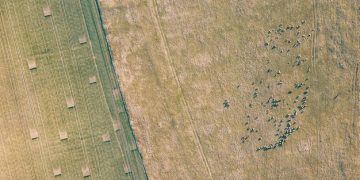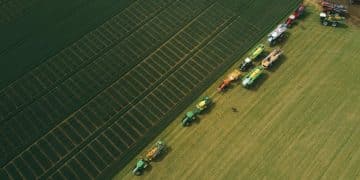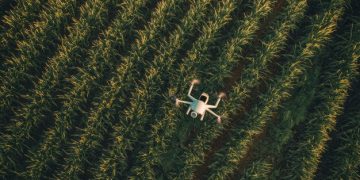Drone Crop Monitoring: Cut Fertilizer Costs by 20% with Early Detection
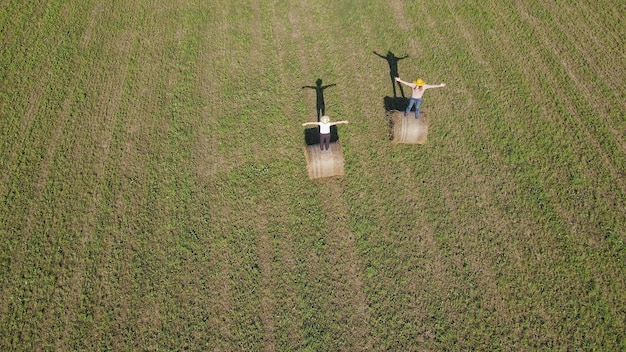
Drone-based crop monitoring empowers farmers to detect diseases early, optimize fertilizer use, and potentially reduce fertilizer costs by up to 20% through data-driven insights and targeted interventions.
Imagine reducing your fertilizer costs by 20% while simultaneously improving crop health. That’s the potential of drone-based crop monitoring, a technology revolutionizing farm management through early disease detection and optimized resource allocation.
The Rise of Drone Technology in Agriculture
Drones are no longer just toys; they’re powerful tools transforming various industries, including agriculture. With advancements in sensor technology and artificial intelligence, drones offer farmers unprecedented insights into their crops, enabling more efficient and sustainable practices. This technology minimizes waste and optimizes resource allocation, ensuring an increase in profitability.
Why Drones are Becoming Essential for Modern Farming
In today’s competitive agricultural landscape, optimizing yields and reducing costs is paramount. Drones provide a cost-effective way to collect data, identify problems early, and make informed decisions. Their ability to cover large areas quickly and accurately offers a significant advantage over traditional methods.
Drone based systems improve the process in the following ways:
- Efficient data collection across large fields
- Early detection of diseases and pests
- Precise application of fertilizers and pesticides
- Reduction in labor costs and time
Ultimately, drone technology is about smarter farming and ensures effective resource allocation within a farming operation.
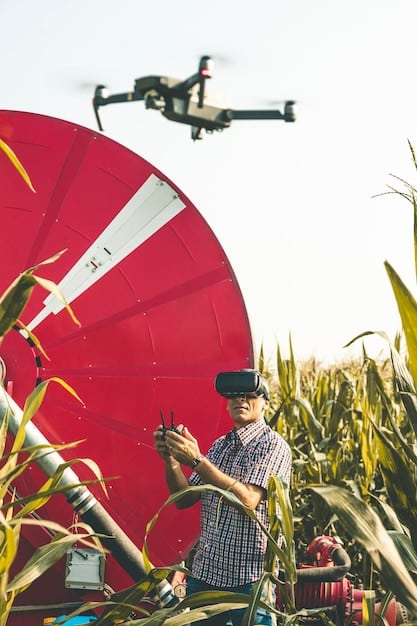
How Drone-Based Crop Monitoring Works
The core of drone-based crop monitoring lies in its ability to collect data using advanced sensors and cameras. This data is then processed and analyzed to identify patterns and anomalies that may indicate stress, disease, or nutrient deficiencies. It offers an effective decision-making tool for farmers.
The Data Collection Process
Drones are equipped with various sensors, including RGB cameras, multispectral cameras, and thermal sensors. These sensors capture different types of data, providing a comprehensive view of crop health. The data collected is then processed using specialized software to generate actionable insights.
- RGB cameras capture high-resolution images for visual inspection
- Multispectral cameras measure light reflectance to assess plant health
- Thermal sensors detect temperature variations, indicating stress or disease
Each sensor serves a critical role in understanding the health and condition of the area scanned by the drone.
Early Disease Detection: A Game Changer
Early disease detection is one of the most significant benefits of drone-based crop monitoring. With the ability to identify diseases before they become widespread, farmers can take swift action to protect their crops and minimize losses. Early detection helps prevent large scale loss.
Identifying Diseases Before Visual Symptoms Appear
Multispectral cameras can detect subtle changes in plant reflectance that are not visible to the naked eye. These changes can indicate the onset of disease, allowing farmers to intervene early and prevent further spread. This proactive approach saves time and resources.
The various ways in which early detection prevents loss is:
- Timely application of treatments
- Prevention of widespread infection
- Minimization of crop losses
Optimizing Fertilizer Use with Drone Data
Fertilizer is a significant expense for farmers. Drone-based crop monitoring enables precise fertilizer application, ensuring that crops receive the nutrients they need without wasting resources. Optimized use is a responsible and effective use of resources.
Applying specific amounts of fertilizer to specific locations means:
- Reduced fertilizer costs
- Improved crop yields
- Minimized environmental impact
Precision agriculture improves yields on a small scale which increase profits.
The Economic Benefits: Reducing Fertilizer Costs by 20%
The combination of early disease detection and optimized fertilizer use can lead to substantial cost savings. Studies have shown that farmers using drone-based crop monitoring can reduce their fertilizer costs by as much as 20%. This optimization provides benefits for the environment and the budget.
Case Studies: Real-World Examples of Cost Savings
Several case studies have demonstrated the economic benefits of drone-based crop monitoring. Farmers who have adopted this technology have reported significant reductions in fertilizer costs, increased yields, and improved overall profitability.
Examples include:
- Increased yields by up to 15% due to early disease detection and targeted treatments.
- Reduced fertilizer costs by 20% through precise application.
- Improved water usage efficiency, leading to lower irrigation costs.

Implementing Drone-Based Crop Monitoring on Your Farm
Implementing drone-based crop monitoring on your farm may seem daunting, but it can be a straightforward process with the right guidance. By understanding the initial investments and long-term benefits, farmers can develop a feasible plan for implementing a smart plan now.
Steps to Get Started
Getting started with drone-based crop monitoring involves several key steps, including choosing the right drone and sensors, selecting appropriate software, and training personnel. Farmers should work with expert to guarantee proper adherence to federal and state rules, as well as ensure they are operating their equipment safely.
Here are some preliminary steps to take:
- Assess your needs and goals.
- Choose the right drone and sensors for your crops and farm size.
- Select appropriate software for data processing and analysis.
- Train personnel on drone operation and data interpretation.
The Future of Drone Technology in Agriculture
The future of drone technology in agriculture holds immense promise. Further advancements in AI, sensor technology, and drone capabilities will continue to revolutionize farming practices. The key for farm operators is to stay informed and adopt new techniques as they become available.
Emerging Trends and Innovations
Emerging trends in drone technology include autonomous drones, advanced data analytics, and integration with other precision agriculture tools. These innovations will further enhance the efficiency and effectiveness of crop monitoring.
Other advancements include:
- Autonomous drones that can fly and collect data without human intervention.
- AI-powered data analytics for more accurate and timely insights.
- Integration with other precision agriculture tools, such as GPS-guided tractors and variable-rate applicators.
Farmers must learn new applications to remain effective.
| Key Point | Brief Description |
|---|---|
| 🌱 Early Disease Detection | Detect diseases before symptoms appear, minimizing crop losses. |
| 💰 Fertilizer Optimization | Apply fertilizer precisely where needed, cutting costs and waste. |
| 🛰️ Multispectral Imaging | Use advanced cameras for detailed crop health analysis. |
| 📈 Increased Yields | Strategic use of drones with smart fertilizers, increases growth. |
Frequently Asked Questions
▼
Studies show that farmers using drone-based crop monitoring can potentially reduce their fertilizer costs by up to 20% through optimized and targeted applications.
▼
Drones are equipped with RGB cameras for visual inspection, multispectral cameras to measure plant health, and thermal sensors to detect temperature variations indicating stress or disease.
▼
Multispectral cameras detect subtle changes in plant reflectance, often invisible to the naked eye, which indicates the onset of disease, enabling early intervention.
▼
Implementing drone-based crop monitoring involves choosing the right drone and sensors, selecting appropriate software, training personnel, and adhering to federal and state regulations.
▼
Emerging trends include autonomous drones, AI-powered data analytics for more accurate insights, and integration with precision agriculture tools like GPS-guided tractors.
Conclusion
In conclusion, drone-based crop monitoring offers a powerful solution for reducing fertilizer costs and improving crop health through early disease detection and precise resource allocation. By adopting this technology, farmers can enhance their profitability and contribute to more sustainable and efficient agricultural practices for years to come.
